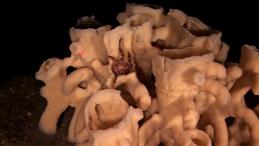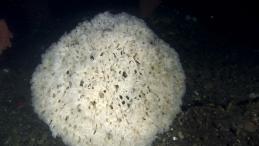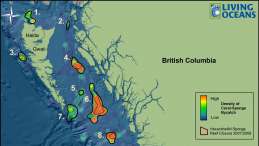Federal government takes a big step forward to protect the Pacific coast of Canada
OTTAWA - Living Oceans Society welcomes today’s announcement by the Minister of Fisheries and Oceans that the ancient glass sponge reefs on Canada’s Pacific coast are one step closer to receiving permanent protection.
“Last summer I experienced the glass sponges first hand while exploring the deep sea in a submarine and I saw the crabs, fish, and shrimp that made these sponges their home,” says Jennifer Lash, Executive Director, Living Oceans Society. “There is no doubt in my mind that protecting these sponges is a critical step forward towards ensuring a healthy ocean.”
The announcement today of the identification of the Hecate Strait/Queen Charlotte Sound glass sponge reefs as an “Area of Interest” within the Pacific North Coast means that Fisheries and Oceans Canada (DFO) will begin the formal process of seeking permanent designation of this area as a Marine Protected Area (MPA).
Scientists have studied fossil records of these sponges from the days when the dinosaurs roamed the Earth. Glass sponges were thought to be extinct, however, in 1987 the sponge reefs were discovered on the Pacific coast of Canada (and extending into Washington State), the only place in the world where they are known to exist. Researchers believe that the largest glass sponge specimens may be 200 years old. Sponges live at depths of 165-240 meters and the reefs can grow to be 21 meters tall.
Glass sponge reefs are vulnerable to fishing gear such as bottom trawling. When scientists proved the that ground fish trawl fishery was damaging the reefs, the fishermen voluntarily stopped fishing in the area. In 2002 DFO used the Fisheries Act to make the closure enforceable. With today’s announcement, DFO will conduct consultations, finalize the boundaries and set the conservation objectives for the sponge reefs with the goal of designating the sponge reefs as a Marine Protected Area.
“These reefs are unique and today’s announcement is a great step forward for marine conservation,” says Lash. “Hopefully, final MPA designation will be announced by 2012 and the glass sponge reefs will be protected in perpetuity.”
-30-
Contact Information
Jennifer Lash, Living Oceans Society, (250) 973-6580
Background
Q: What is a glass sponge?
A: Like all sponges, glass sponges are non-mobile filter-feeding animals that have very simple body plans. Glass sponges are differentiated from other sponges by their skeletons, which are composed of glass spicules (spikes). Individual glass sponges occur in many places around the world, but they only form reefs—massive complexes in which living sponges grow on top of a framework of the skeletons of long-dead sponges—in the waters off of the coast of B.C. and Washington.
Q: Where are they located?
A: The largest and best-known reefs are in Hecate Strait and Queen Charlotte Sound, with smaller reefs also found in the Strait of Georgia and off the coast of Washington State. These are the only places on earth where glass sponge reefs are known to exist.
The total area of the current sponge reef closures is 1,837 km2.
Q: How old are the glass sponges?
A: The oldest part of the oldest reef is over 9,000 years old.
Q: Why do the glass sponge reefs require MPA designation?
A: Glass sponge reefs are known to harbour a diversity of marine invertebrates and fish, so their ecological role as habitat is important enough as it is. However, it is the uniqueness of the glass sponge reefs that sets them apart. Until they were discovered off of B.C.’s coast in the late 1980s, people thought that glass sponge reefs had died out millions of years ago—we knew them only from fossils. So, the reefs off the Pacific coast of Canada are the last survivors of an ecosystem that was relatively common back when dinosaurs existed.
However, the reefs are easily damaged by human activity and they do not recover quickly from sudden impacts. In addition to direct physical impacts, sponge reefs may also be impacted by increased sedimentation from bottom trawling. Therefore, the sponge reefs require Marine Protected Area (MPA) designation, and the protection that comes with it, due to their age (up to 9,000 years old), their susceptibility to human impacts (including both direct, physical impacts and indirect ones such as increased sedimentation), their slow recovery from human impacts, and their status as a last remainder of an ancient ecosystem that exists nowhere else on Earth. As far as we know, they are literally survivors from the age of dinosaurs.
Q: What are some of the potential threats to the glass sponge reefs?
A: Until 2002, the primary threat to the glass sponge reefs was bottom trawling and there were no regulated closures for bottom trawling in the glass sponge reef areas. However, since 2002, the glass sponge reef areas have been closed to bottom trawling.
Bottom trawling is a fishing method that uses weighted nets, pulled along the seafloor, to catch bottom-dwelling fish. Bottom trawling is widely considered to be an unselective and damaging fishing method, because it damages or destroys sponges, corals and other marine habitat, and catches substantial amounts of non-targeted ‘bycatch’ species which are often thrown back overboard, dead or dying. When the glass sponge reefs were discovered, researchers noted the obvious damage that had been caused by recent bottom trawling.
While the glass sponge reefs have been closed to bottom trawling since 2002, these closures must be renewed annually and as such they do not offer a guarantee of permanent protection for the reefs. Furthermore, they do not address other human activities that may impact the reefs, such as the laying of undersea cables or oil and gas exploration. The MPA designation should also follow Canada’s own scientific advice by including a provision for a ‘buffer’ zone around the perimeter of the sponge reefs to ensure that human activities, most notably bottom trawling, do not erroneously enter the sponge reefs and do not endanger the reefs with smothering by re-suspended sediment. MPA designation will give B.C.’s glass sponge reefs the permanent protection that they require.



